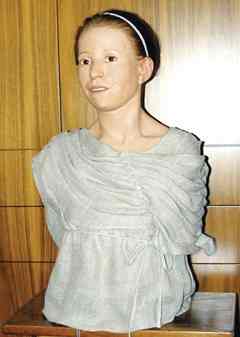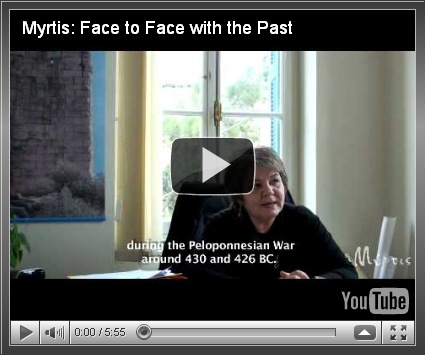Myrtis' has attracted thousands of people across Greece to see her, has appealed to the world leaders to end the spread of disease and now she earns herself a place amongst historic artefacts in the National Archaeological Museum in Athens. All this, and her name isn't actually Myrtis.
 It was the name that was given to her by scientists who uncovered her remains, as well as over 150 other skeletons, from an archaeological dig of a 'plague grave' at Kerameikos Cemetery dating back between 426-430BC. Myrtis' resurrection some 2,500 years after her death from Typhoid - a plague which wiped out a third of the Athenian state including Pericles during the Peloponnesian War - has proved useful to researchers who took samples from her teeth to understand more about the microbe which led to the deaths of so many. Other interesting facial reconstructions include that of King Tutankhamun, the Egyptian boy king.
It was the name that was given to her by scientists who uncovered her remains, as well as over 150 other skeletons, from an archaeological dig of a 'plague grave' at Kerameikos Cemetery dating back between 426-430BC. Myrtis' resurrection some 2,500 years after her death from Typhoid - a plague which wiped out a third of the Athenian state including Pericles during the Peloponnesian War - has proved useful to researchers who took samples from her teeth to understand more about the microbe which led to the deaths of so many. Other interesting facial reconstructions include that of King Tutankhamun, the Egyptian boy king.
The reconstruction of Myrtis came about as her skull was discovered intact, and complete with her jaw and teeth (a mixture of both adult and milk teeth). Orthodontics professor Manolis Papagrigorakis led the project to team to rebuild the face of Myrtis, using techniques involving markers or little nails that show the thickness of the tissue, as well as by considering the origin, the sex, the living conditions and the age of her skull. To recreate the muscles and the tissue, the face is sculpted with the markers acting as a basic guide as to the how thick the sculpting clay should be. The shape and size of eyes and nose were calculated from the size of the ocular and nasal cavities.

Papagrigorakis felt Myrtis' resurrection should not only be an opportunity for the world to see the face of a girl who played at the Acropolis while the Athenians were building the Parthenon, but he also wanted her return to send a strong message to world leaders. So, Myrtis was made a 'Millennium Friend', and acts as an ambassador for the UN Millenium Development Goals - an agreement between all 192 member states to tackle, amongst other issues, the threat of disease and epidemics.
On a website dedicated to the young Athenian girl, she writes: "My death was inevitable. In the 5th century BC we had neither the knowledge nor the means to fight deadly illnesses. However, you, the people of the 21st century, have no excuse. You possess all the necessary means and resources to save the lives of millions of people. To save the lives of millions of children like me who are dying of preventable and curable diseases.
"2,500 years after my death, I hope that my message will engage and inspire more people to work and make the Millennium Development Goals a reality. Listen to me. I know what I’m saying. Never forget that I’m much older and therefore much wiser than you.”
Source: Heritage Key [September 01, 2010]